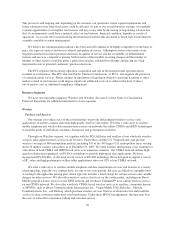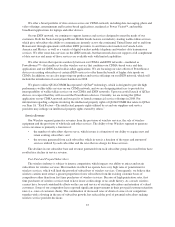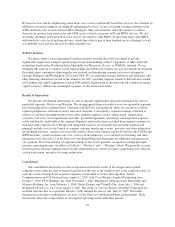Sprint - Nextel 2007 Annual Report Download - page 42
Download and view the complete annual report
Please find page 42 of the 2007 Sprint - Nextel annual report below. You can navigate through the pages in the report by either clicking on the pages listed below, or by using the keyword search tool below to find specific information within the annual report.volume-based pricing. In addition to our standard voice plans, we offer data plans or add on plans that provide
our customers offerings such as short message service, or SMS, connection cards and our Sprint Vision and
Power Vision service plan. As these products and services are becoming increasingly popular with our
customers, the decline in the average voice revenue per subscriber is being partially offset by an increase in the
average data revenue per post-paid subscriber. There is no assurance that data service revenue per subscriber will
continue to grow at current rates or eventually offset the declines in voice revenue.
Segment Earnings
Wireless segment earnings is primarily a function of wireless service revenue, costs to acquire subscribers,
network and interconnection costs to serve those subscribers and other Wireless segment operating expenses. The
costs to acquire our customers includes the net cost at which we sell our handsets, referred to as handset
subsidies, as well as the marketing and sales costs incurred to attract those customers. Network costs primarily
represent switch and cell site costs and interconnection costs generally consist of per-minute use fees and
roaming fees paid to other carriers. The remaining costs associated with operating the Wireless segment include
the costs to operate our customer care organization, back office support and bad debt expense. Wireless service
revenue, costs to acquire subscribers, and network and interconnection costs are generally variable in nature and
fluctuate with the growth in our subscriber base but certain elements are fixed.
800 Megahertz Spectrum Reconfiguration
Under the FCC’s Report and Order, we are required to complete a reconfiguration plan that is designed to
eliminate interference with public safety operators in the 800 MHz spectrum band through a spectrum
reallocation that will result in more efficient use of 800 MHz spectrum. For a more detailed discussion of the
Report and Order and its impact on us, see Item 1. Business–Legislative and Regulatory Developments—
Regulations and Wireless Operations–800 MHz Band Spectrum Reconfiguration.
The Report and Order implemented rules to reconfigure spectrum in the 800 MHz band in a 36-month
phased transition process. We surrendered certain portions of our holdings in the 800 MHz spectrum band and
are obligated to fund the cost incurred by public safety systems and other incumbent licensees to reconfigure the
800 MHz spectrum band. As part of this process, in most markets, we must cease using portions of 800 MHz
spectrum during the reconfiguration before we are able to commence use of replacement 800 MHz spectrum.
Based on the terms of the Report and Order and subsequent FCC and 800 MHz Transition Administrator, or TA,
actions, we have been planning and implementing spectrum exchanges with each affected public safety agency
based upon that agency’s ability to complete the reconfiguration process, thereby limiting the time from when we
cease using the surrendered spectrum and when the replacement spectrum is available for our use. In
September 2007, the FCC issued an order, the Third MO&O, that, among other things, requires that by June 2008
we vacate many 800 MHz channels that we currently use, even if the applicable public safety licensee is not
ready to relocate to the vacated spectrum, which could result in a sudden and significant decrease in network
capacity, which in turn would adversely affect the performance of our iDEN network. We have appealed this
order in the U.S. Court of Appeals for the D.C. Circuit.
If this order is not overturned or modified, we could attempt to construct additional sites or acquire
additional spectrum, to the extent possible. In those markets where these network investments are not possible,
we may be required to curtail subscriber additions and incent certain existing subscribers of iDEN services to use
PowerSource devices or move to our CDMA network until the capacity limitation can be alleviated, particularly
if the replacement 800 MHz spectrum is not available for an extended length of time. Degradation in network
performance in any market could result in higher subscriber churn in that market. The loss of a significant
number of subscribers could adversely affect our results of operations.
Based on the FCC’s determination of the values of the spectrum rights received and surrendered, the
minimum obligation to be incurred under the Report and Order is $2.8 billion. The Report and Order also
40
























